When smoking meat, you'll want to choose native hardwoods that complement your specific cut. Oak offers versatility for beef and lamb, while hickory delivers a bold flavor perfect for pork. For fish and poultry, try maple's gentle sweetness or alder's light touch. Always avoid softwoods like pine or fir, as they contain toxic resins. Look for thin, blue-white smoke and a sweet aroma – that's your signal for proper combustion. Store your wood in a cool, dry place and match the size to your cooking duration. Understanding your local wood options will reveal even more authentic smoking possibilities.
Native Woods for Smoking
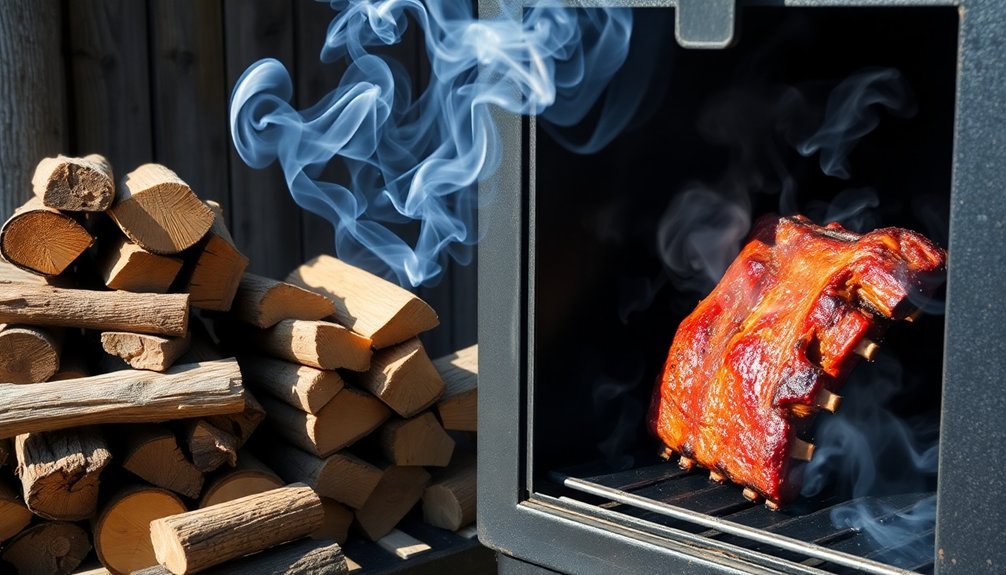
The art of smoking meat starts with selecting the right native wood species. You'll find several hardwoods that deliver exceptional smoking results, with oak serving as a versatile choice for beef, lamb, and sausages. Clean smoke quality results from properly dried hardwoods with minimal resin content.
If you're smoking pork or chicken, hickory provides a powerful flavor, though you'll want to use it sparingly to avoid overwhelming your meat.
For a more subtle approach, maple wood imparts a gentle sweetness that works beautifully with pork and fish, while ash offers a light to medium flavor that's perfect for poultry and beef.
When you need intense heat and spicy notes, mesquite is your go-to choice, particularly for chicken and pork dishes.
You can also experiment with less common native woods to create unique flavor profiles. Alder delivers a light, sweet taste that's traditionally used for salmon, while almond provides a nutty sweetness that complements all meats.
If you're feeling adventurous, try blackberry wood for a mild, fruity finish, or lilac for smoking cheese and poultry.
Remember that some woods, like black walnut, have intense flavors and work better when mixed with milder varieties.
Understanding Wood Smoke Quality
You'll notice a significant difference between clean smoke (thin, blue-white) and dirty smoke (thick, dark) when smoking your meat, as clean smoke produces better flavor while dirty smoke can make your food taste bitter.
The color of your smoke tells you everything about its quality: blue smoke signals ideal conditions, while white smoke suggests moisture issues, and black smoke indicates serious problems like burning or insufficient airflow.
You can control smoke quality by managing your fire's temperature, ensuring proper airflow, and using well-seasoned wood that's neither too wet nor too dry. The proper moisture content balance in your smoking wood is essential for achieving the best smoke production without creating unwanted bitter flavors in your meat.
Clean Vs Dirty Smoke
Mastering wood smoke quality stands as an essential foundation for successful meat smoking. You'll want to recognize the difference between clean and dirty smoke to achieve the best results for your smoked meats.
Clean smoke appears thin, blue-white, and nearly transparent, indicating proper wood combustion with adequate oxygen. You'll get this ideal smoke when using properly seasoned hardwoods with balanced moisture content. When your fire's burning right, you'll notice a sweet, pleasant aroma rather than an acrid smell. The optimal temperature for producing clean smoke is between 650-750°F for the best flavor compounds.
| Characteristic | Clean Smoke | Dirty Smoke |
|---|---|---|
| Appearance | Thin, blue-white | Thick, gray or black |
| Smell | Sweet, pleasant | Acrid, bitter |
| Combustion | Complete, proper oxygen | Incomplete, smoldering |
| Wood State | Seasoned, proper moisture | Too wet or green |
To maintain clean smoke, you'll need to avoid common pitfalls like using green wood or soaked chunks. Don't use softwoods like pine or fir, as their high sap content produces undesirable smoke. Keep your wood supply consistent and properly stored, and you'll notice a significant improvement in your smoke quality. Remember that adding new wood during cooking requires careful management to prevent dirty smoke from developing.
Smoke Color Matters
Smoke color serves as a key indicator of both wood quality and cooking progress when smoking meat. Different wood types produce distinct smoke colors that directly impact your food's appearance and flavor profile.
When you're looking for pronounced coloring, hickory and red oak are your best choices, as they generate intense, dark smoke that creates a robust outer appearance on your meats.
For a more subtle approach, you'll want to take into account woods like alder and ash, which provide neutral coloring without overwhelming the natural appearance of your food. Cherry wood offers a unique middle ground, adding an attractive reddish hue while maintaining a mild flavor profile.
If you're after consistent results, maple delivers beautiful, even coloring with moderate flavor intensity.
You'll want to avoid woods like cottonwood, elm, and sycamore, which can produce undesirable colors and flavors in your food. Instead, stick to proven performers like oak, which offers reliable smoke quality and consistent coloring.
Remember that dense woods like hickory and pecan will produce more intense colors, so use them sparingly if you're aiming for a lighter finish on your smoked meats.
Temperature Controls Smoke Quality
Temperature management stands as the cornerstone of producing quality smoke for your meats. You'll want to maintain temperatures between 200-250°F, as this range creates the perfect environment for consistent, clean smoke production.
When you're smoking meat, this temperature zone helps break down connective tissues while allowing proper smoke penetration.
You'll find that temperature directly impacts how your wood burns and the quality of smoke it produces. If you're running too hot, you'll generate excessive smoke that can lead to bitter flavors. The ideal range guarantees your wood releases its flavor compounds – including phenols, carbonyls, and acids – at the right rate.
For most cuts of meat, poultry, and fish, you'll want to stay between 180-225°F.
When you're selecting wood, remember that different species perform best at specific temperatures. Fruitwoods like apple and cherry work better at lower temperatures, while denser hardwoods like hickory and oak can handle higher heat.
You'll achieve the best results by matching your wood choice to your target temperature and using properly seasoned wood that's neither too wet nor too dry.
Matching Woods With Meats
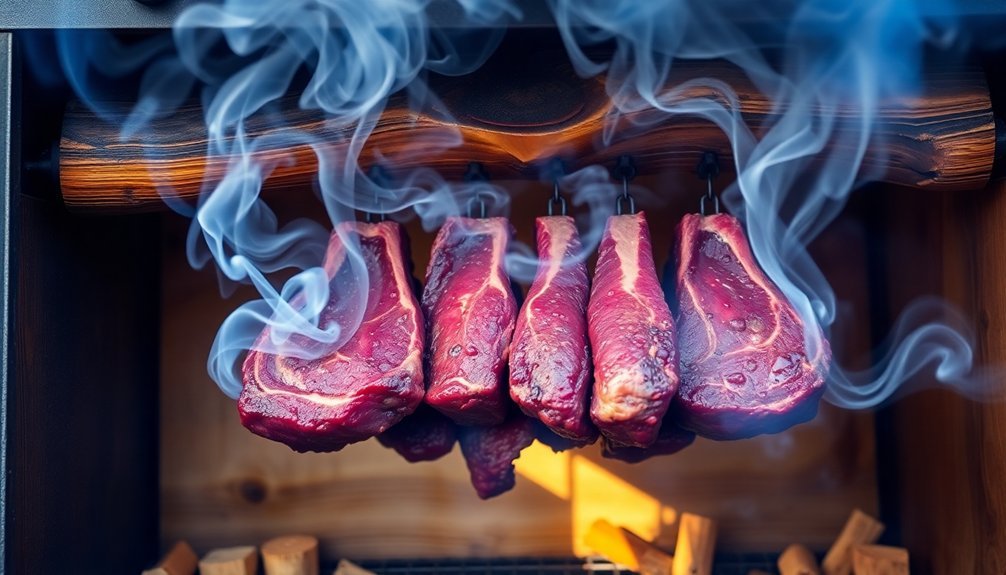
Pairing the right wood with your meat is essential for achieving that perfect smoky flavor. For heavier meats like beef and lamb, you'll want to use stronger woods such as oak or hickory.
Oak provides a robust flavor without overpowering, while hickory adds intensity but should be used moderately to prevent bitterness. Mesquite works well for grilling but burns hot and fast.
When smoking lighter meats like pork and poultry, opt for fruit woods. Apple and cherry wood impart a mild, sweet flavor that complements these meats perfectly.
Cherry has the added benefit of giving your meat an appealing color, though apple wood might slightly discolor chicken skin.
For fish and seafood, you'll find alder is your best choice, especially for salmon. It provides a light flavor and smokes at lower temperatures.
Ash and birch are also excellent options for seafood smoking.
If you're smoking vegetables, stick with mild fruit woods like apple, cherry, or peach.
Maple works well too, offering a light flavor that won't overwhelm your produce. Citrus woods provide a subtle fruity note that enhances vegetable flavors without adding heaviness.
Dangerous Woods to Avoid
You'll want to steer clear of all softwoods like pine, fir, and spruce because their high sap content creates toxic smoke that can make you sick and ruin your meat.
Common toxic woods to watch out for include oleander, sassafras, and laburnum, which contain dangerous chemicals that can transfer into your food.
Don't take chances with treated lumber, moldy wood, or unidentifiable pieces, as these materials often harbor harmful substances that can lead to serious health problems when used for smoking.
Softwoods Create Harmful Smoke
The dark side of smoking meat emerges when using softwoods, which create dangerous and unpalatable smoke that can ruin your food and pose serious health risks.
You'll find that softwoods contain high levels of resin, leading to thick, acrid smoke and the formation of creosote, a flammable substance that can cause chimney fires.
When you burn softwoods, their naturally high moisture content combines with resin to produce excessive smoke filled with terpenes and toxic compounds. This combination creates bitter, unpleasant flavors in your meat and can cause respiratory irritation, coughing, and eye discomfort.
The steam produced from the wet wood interferes with proper smoking, making it nearly impossible to control the process effectively.
You'll also notice that softwoods burn too hot and fast, creating sparks and releasing harmful fumes that can make people sick.
The creosote buildup from burning these woods isn't just a flavor concern – it's a serious safety hazard that can lead to dangerous chimney fires.
For both your health and the quality of your smoked meats, you should strictly avoid using softwoods in your smoking process.
Common Toxic Wood Types
Staying safe while smoking meat requires knowing which woods to completely avoid, as many species can release dangerous toxins or irritants when burned. You'll need to be particularly cautious of hardwoods like oleander, which contains lethal compounds throughout the entire tree, and yew, which harbors the deadly alkaloid taxine in nearly all its parts.
Many exotic woods pose serious health risks too. Rosewood, teak, and cocobolo contain natural oils that can trigger severe allergic reactions when burned. The manchineel tree is especially dangerous, with toxic sap that can cause extreme reactions even from its smoke.
| Wood Type | Primary Toxin | Health Risk |
|---|---|---|
| Oleander | Cardiac Glycosides | Severe poisoning, death |
| Yew | Taxine | Heart failure, death |
| Manchineel | Phorbol Esters | Severe burns, respiratory failure |
Never use chemically treated woods, lumber scraps, or wood from orchards, as these materials often contain harmful pesticides and preservatives. Also avoid any wood showing signs of mold or fungal growth. Woods containing urushiol, like poison ivy, poison oak, and Mexican pepper, can cause serious respiratory problems when burned.
Avoiding Bad Health Effects
Before lighting your first smoking session, familiarize yourself with dangerous wood types that can ruin both your meat and health.
Softwoods like pine, cedar, and spruce contain high levels of sap and turpenes that'll make your food taste terrible and could make you sick. While cedar planks are fine for cooking salmon, don't burn them for smoke.
Never use wood if you're unsure of its origin or treatment history. Chemically treated lumber, painted wood, and old furniture pieces can release harmful toxins into your food. This includes wood from old orchards that might've been sprayed with pesticides.
You'll also want to avoid any wood that's showing signs of mold, as burning it can release dangerous toxins and affect your respiratory system.
- Avoid all softwoods and resinous woods due to their high sap content
- Don't use lumber or wood pallets, as they're often chemically treated
- Never burn painted, stained, or moldy wood
Remember that inefficient burning creates more smoke with fine particles and pollutants. This is especially dangerous for children, older adults, and those with heart or lung conditions, including people recovering from COVID-19.
Proper Wood Storage Methods
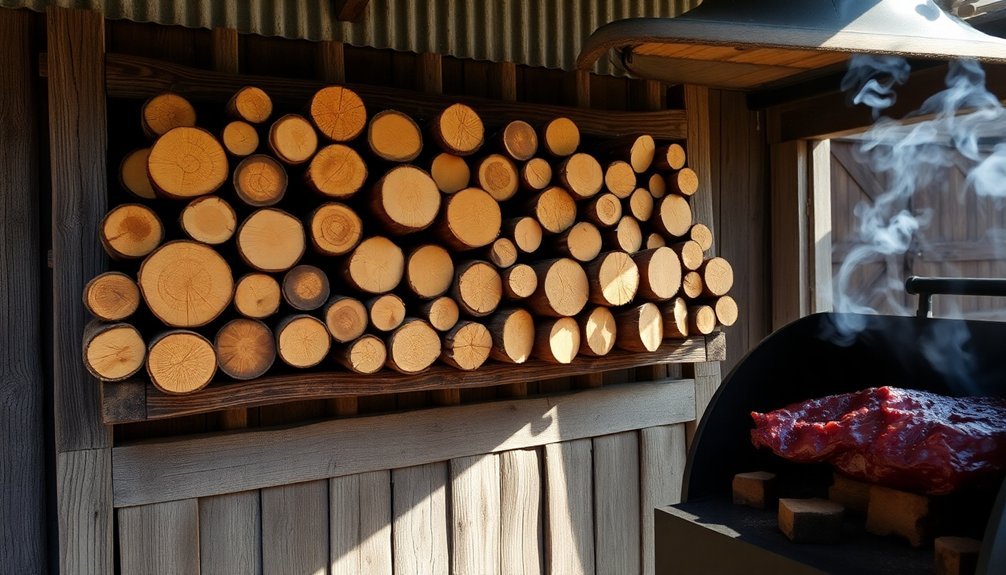
Properly storing your smoking wood guarantees ideal flavor and prevents waste while extending its usable life. You'll need to store your wood outdoors or in a garage, keeping it away from direct sunlight and walls where moisture can build up. Always elevate your wood on pallets to promote airflow and prevent ground contact.
| Storage Factor | Best Practice |
|---|---|
| Location | Cool, dry areas like garages; away from walls |
| Container | Wood, metal, or cardboard containers; avoid plastic |
| Moisture Level | Maintain 20% moisture; don't soak wood |
| Airflow | Use elevated storage; remove from sacks |
You'll want to inspect your wood regularly for mold and sun damage. If you're using pellets, they should be shiny and snap when broken. Don't forget to empty your hopper after each use and store leftover pellets in a sealed container. For best results, maintain proper air circulation by keeping wood away from obstacles. If you're dealing with high humidity, rotate your unused wood periodically and use sealed containers to protect against ambient moisture. Remember to perform a burnoff after cooking to keep your auger system clean.
Wood Size and Form Matters
The size and form of your smoking wood directly impacts your barbecue results. When you're choosing between chunks, chips, pellets, or discs, you'll need to match the wood form to your specific cooking needs.
Wood chunks are your best choice for long smoking sessions. These fist-sized pieces burn slowly and steadily, making them perfect for large cuts like brisket, whole birds, and pulled pork.
If you're smoking smaller cuts or need quick flavor, wood chips are your go-to option, though they'll burn out faster than chunks.
For shorter cooks, consider these primary wood forms:
- Wood pellets – ideal for chicken breasts and steaks, but require frequent replacement
- Wood chips – perfect for small cuts and quick smoke flavor
- Wood discs – offer consistent smoke and work well in specialized smokers
Pellets burn hot and fast, making them suitable for shorter smoking sessions but challenging for extended cooks.
Wood discs, while less common, provide steady smoke output and are an environmentally conscious choice since they're made from compressed sawdust.
Remember that matching your wood size to your cooking duration and meat cut will greatly improve your smoking results.
Regional Wood Smoking Traditions
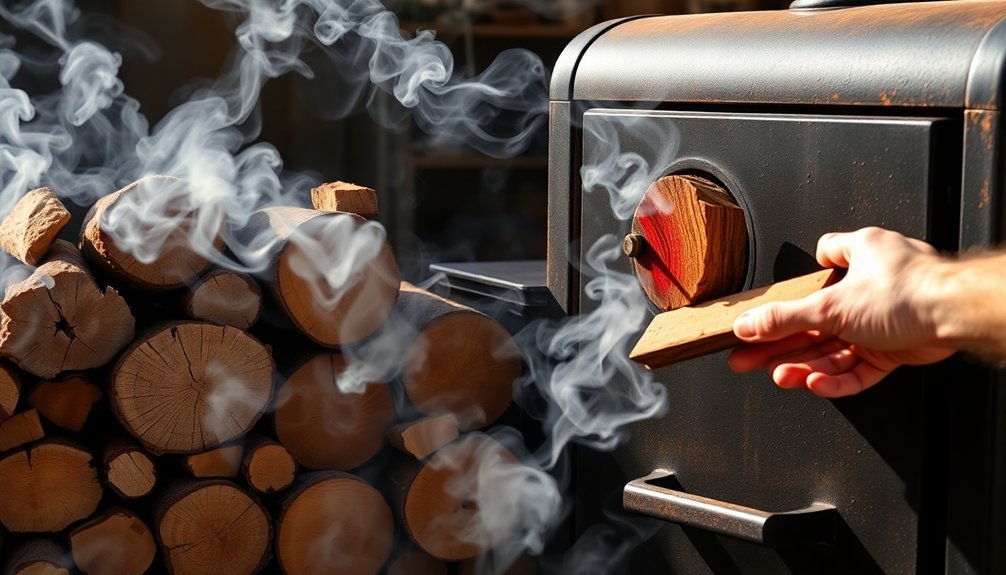
Smoked meat traditions across America tell a fascinating story of regional flavors and techniques. In the South, you'll find hickory wood dominating the smoking scene, while pecan wood adds its signature nutty notes, especially in Texas and Louisiana. The region's BBQ is often enhanced with distinctive Creole and Cajun seasonings that have become part of the cultural fabric.
New Orleans brings its own spin to wood smoking, favoring pecan wood and complex spice blends that reflect the city's rich culinary heritage. You'll discover that the local wood choices and bold seasonings create a uniquely New Orleans BBQ experience.
The Western states embrace mesquite wood, which delivers an intense, bold flavor that's become synonymous with Southwest cooking. This tradition stems from both Native American practices and pioneer adaptations to the harsh desert environment.
Native American smoking techniques offer a different approach, focusing on wilderness materials and low-heat smoking methods. You can replicate these traditional methods using hardwoods like oak, maple, or hickory, maintaining a low, smoldering fire to achieve the perfect smoke for your meat preservation and cooking needs.
Frequently Asked Questions
Can I Mix Wood Chips With Charcoal in My Smoker?
Yes, you can mix wood chips with charcoal in your smoker. Just soak the chips for 30 minutes first, then place them on hot coals or in a foil packet to create flavorful smoke while cooking.
How Long Should I Let Fresh-Cut Wood Age Before Smoking?
You'll need to age fresh-cut wood for at least 6 months, but no more than 18 months. This guarantees proper moisture reduction and flavor development. Check for silvery tones and small cracks to confirm it's ready.
Does Altitude Affect Wood Smoking Temperature and Time?
Yes, altitude affects your smoking process considerably. You'll need to increase cooking time by 5-10% and adjust temperatures higher to compensate for lower oxygen levels and reduced atmospheric pressure at higher elevations.
Can Smoking Wood Be Reused for Multiple Cooking Sessions?
You shouldn't reuse smoking wood as it's usually fully burned after use. If any pieces remain, they won't provide much flavor. Instead, use fresh wood chips or chunks for each cooking session to guarantee the best results.
Will Painted or Treated Lumber Work if I Remove the Outer Layer?
Don't use painted or treated lumber even if you remove the outer layer. The toxic chemicals penetrate throughout the wood and can't be removed. They'll release dangerous substances when burned, seriously risking your health.
In Summary
You'll get the best smoking results by choosing local native woods, storing them properly, and matching them thoughtfully to your meats. Remember to avoid toxic woods, use the right size chips or chunks, and learn from regional traditions in your area. Whether you're smoking with hickory, oak, apple, or maple, you're carrying on an age-old cooking tradition that brings incredible flavor to your food.

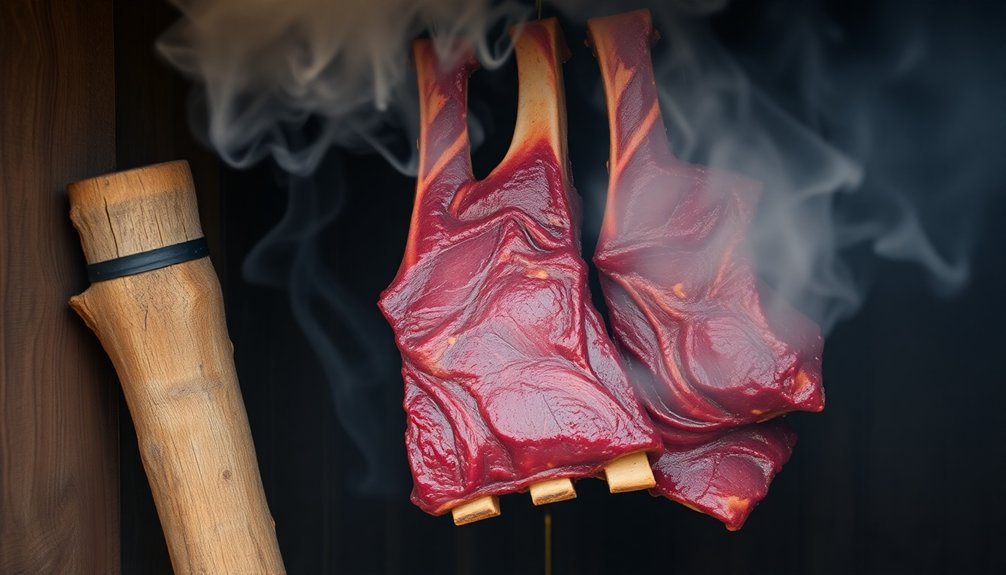



Leave a Reply